Wind and ice on mars

A glance at Mars from orbit evokes a curious feeling of combining the familiar and the unfamiliar. Somewhere you can see sand dunes, the same as on Earth. At the poles lie caps of ice, generating the same wind that blows in Antarctica. Dust eddies travel along warm areas, the physical principle of which is similar to the eddies that will twist and carry light garbage up outside your window this summer. But at the same time, there are phenomena that are not on Earth. Not far from the poles in the spring gas geysers are beating, polygons from ice cracks are visible on the dunes. It is a bit funny to know that the blue sunset on Mars and the red one on Earth give rise to the same physical laws. And it's very, very beautiful ...
Dunes
You should probably start with this picture, which looks almost home-like. Sand dunes, 300 kilometers from the polar ice cap at the north pole, combined image in the infrared and visible ranges:

Full size photo link
The combination of the visible and infrared range gives us a picture in artificial colors - the dunes are actually dark gray, they heat up in the sun and are painted in shades of yellow in the photo. And colder areas are shown in shades of blue. The round white spot at the bottom of the photo is a hill about 100 meters high, covered with ice.
')
But the sand dunes on Mars
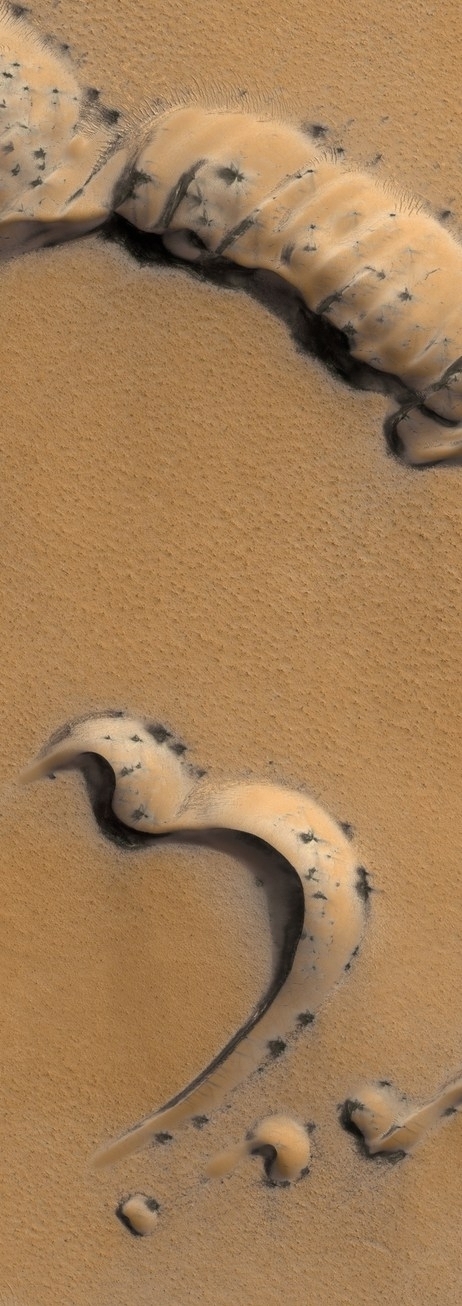
Barchan is a curved relief shape that forms when there is sand and wind. The wind sweeps the sand on the windward side, creating a gentle slope that falls under the influence of gravity on the leeward side.

An angle of 34 ° is typical of terrestrial conditions. On Mars, the force of gravity is less, and this leads to an interesting effect - the slope can accumulate at a greater angle, but when it began to crumble, it will crumble to a smaller angle than on Earth.
Dunes - an interesting thing. When two dunes are near, they can merge into one, generate many new ones, the smaller of them can be divided into two parts, and sometimes they, like solitons, can pass through each other, retaining their shape:
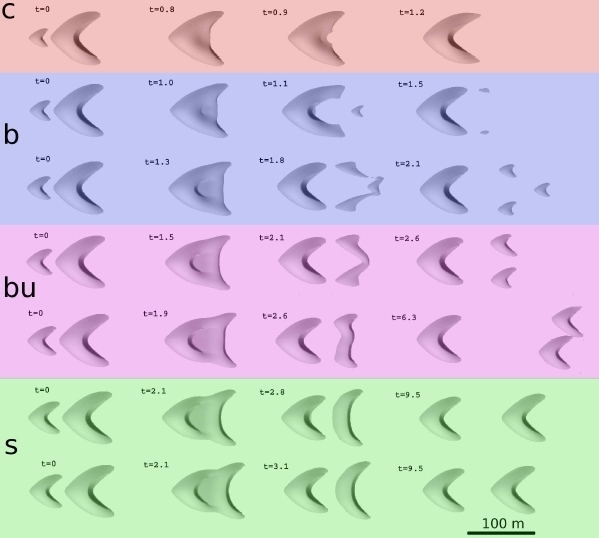
In many ways, the wonderful film Martian could have created a misconception about Martian winds and sandstorms. Do not forget that the pressure on the surface of Mars is about 1% of Earth's, and the wind needs to blow very quickly to create any appreciable pressure. And the speed of Martian storms does not exceed 100 km / h, earthly storms are faster. The density of the atmosphere is only enough for light wind and dust whirlwinds:

The mechanism of formation of a dust vortex is simple - the surface is heated by the sun, it transfers some of the heat to the surface layers of the atmosphere, and they become lighter. At some point, the warm, light air begins to rise, twisting for various reasons (convection, relief, the Coriolis force has little effect ), and cold air from above comes in its place. On a sunny summer day on Earth, one can often observe such eddies. Under terrestrial conditions, dust vortices do not exceed several tens of meters in height (thermals start next, but they are invisible). And on Mars you can take a picture of a whirlwind twenty kilometers high.

Full size photo link
But in this photo, our brain, accustomed to looking for familiar forms, will easily find trees.

Full-sized photo with a height of 5400 pixels by reference
Did not notice? Here is a part of the photo more large:

Full-size photo 2500 pixels wide by reference
It seems true? Of course, these are not trees. But on Earth you can find a similar phenomenon. This is a landslide. Every spring, the carbon dioxide ice under the sand evaporates (carbon dioxide ice does not turn into liquid, but immediately turns into gas), and sand descends from the tops of the hills. And if you look closely, on the hills themselves you can find polygons of cracking ice.
Near, not from orbit, the sublimation of dry ice looks like this:
What happens if carbon dioxide lies in a more even area and under a thicker layer of sand? Here's what:

Full-size photo, 15,000 pixels in height, by reference
Dark panicles are a trace of falling out of dust raised by an erupting gas geyser. When the pressure of carbon dioxide at the bottom becomes too large, it breaks up, seizing the ground with it. Soil particles rise into the air and fall in the direction of the wind, so all the "panicles" are directed in one direction. There are no conditions for such an effect on Earth.
You probably already realized that carbon dioxide on Mars can be compared with water on Earth, if we are talking about the time of year. Carbon dioxide snow falls in the fall and evaporates in the spring. For thousands of years, water on Mars lies with ice, so it can be compared more with the Earth’s stones (an important note is that in some places there are perchlorates in the soil of Mars, which work like antifreeze and can make water somewhere liquid, here we are talking about relatively pure water). For example, the ice in the crater near the north pole:

But the North Pole itself:
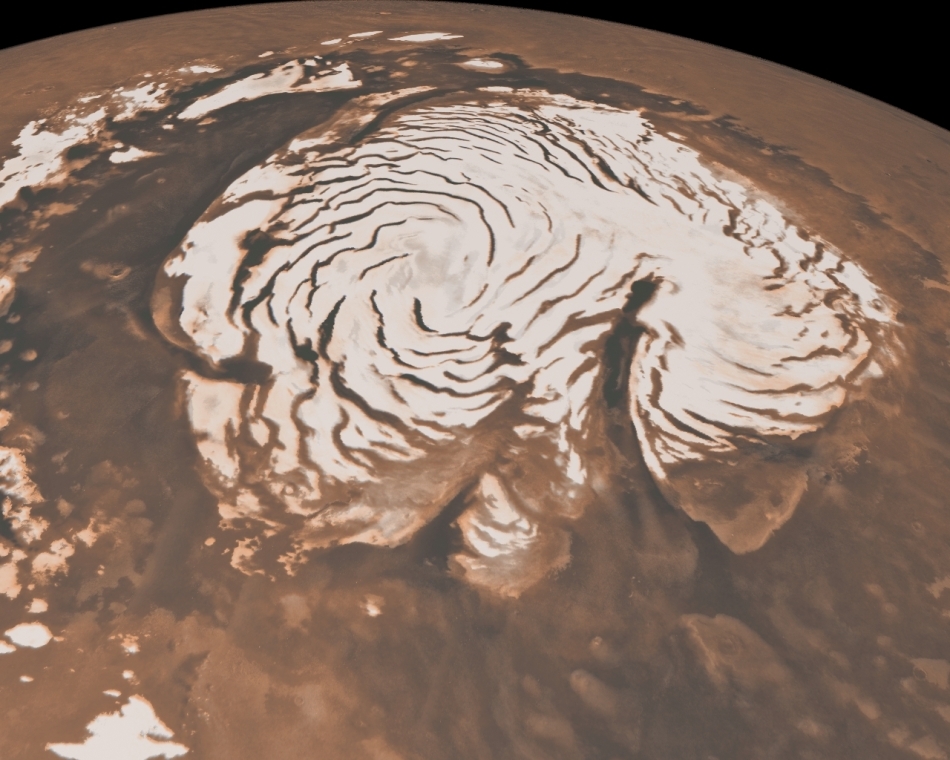
Do not you think that the dark rifts in the ice sheet go in a spiral? So it is, and two phenomena that are on Earth are responsible for this - the force of Coriolis and the katabatic winds. If many have heard something about the Coriolis force (it rejects moving objects on a rotating planet sideways), then it’s necessary to talk about the wind with a scary name in a little more detail. On Earth there is a map of winds formed by uneven heating of the surface (more at the equator, less at the poles)
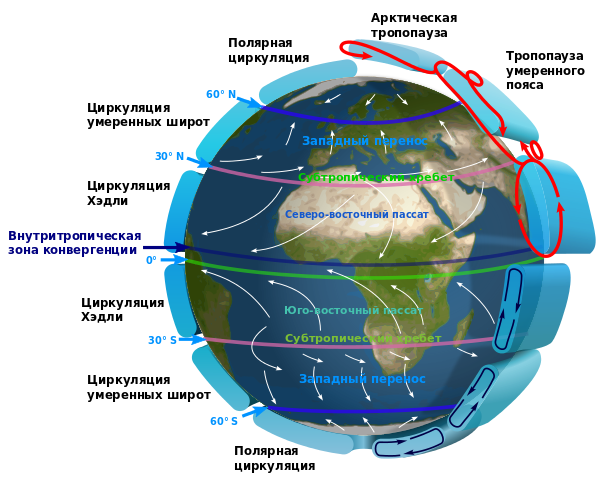
On Mars, this effect is weaker, but at the poles the pressure is greater than at the equator. Therefore, the cold wind begins to blow towards the equator:

And the rotation of the planet deflects this wind to the side. Therefore, spiral faults are formed. And the largest and most noticeable rift - the Northern canyon (Chasma Boreale) has some kind of its ancient history, about which scientists still argue.

Thanks to the satellites, we can make a topographic map and virtually be on the surface of Mars.
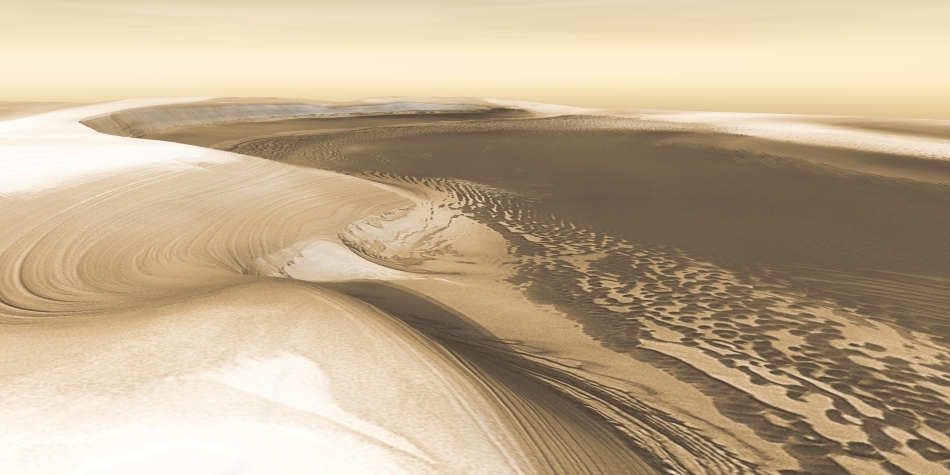
The full version is 4000 pixels wide by reference.
Since we are talking about the wind, it is the cause of blue sunsets on Mars - the dust in the atmosphere absorbs the red part of the spectrum of visible light, so the sky on Mars is reddish in the afternoon, and the direct sun rays turn blue. The same story with the earth's atmosphere, but our atmosphere absorbs the blue part of the spectrum. Here is such a Martian lullaby.
The main source of inspiration for this publication was this post.
Source: https://habr.com/ru/post/394103/
All Articles